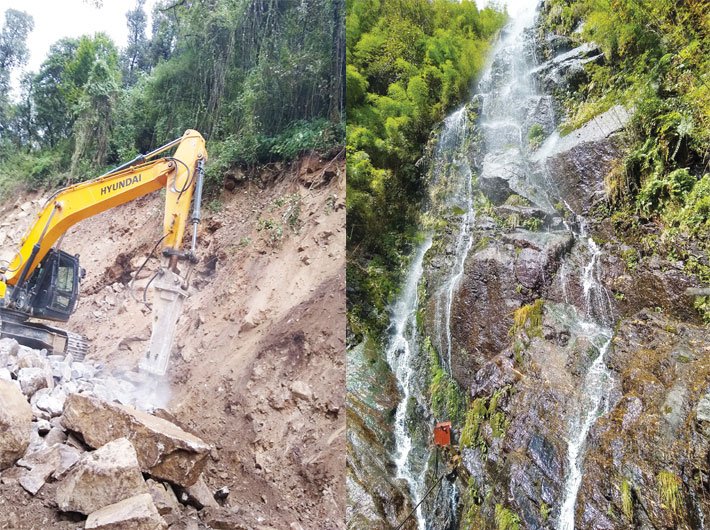Climate change is here and now, and we are clueless how to save vulnerable spots from us
A shocking sight greets the visitor in Rishikesh: At the main ghat, the Ganga spans no more than 10 feet with less than a foot in depth. A larger stream, though, flows on the other side, in full spate, but a sizeable island of sand and stones lies between the that Ganga and the ghat. It was not many years ago that a pilgrim would prefer Triveni Ghat in Rishikesh over Har-ki-Paudi in Haridwar for a majestic view of the Ganga with green hills in the backdrop instead of a waterline bound by the cement-and-concrete structures. Haridwar then defined the point past which the Ganga was bound and dammed. Now that point is inching upwards, closer to the source of the river, at an alarming rate. Sadly, the river is thinning out before our eyes.
There is more than nostalgia for a particular spot in bemoaning what we are losing. The same sad story is repeated elsewhere. In Varanasi, the riverbed is divided equally between the river and the sand. The Yamuna too is thinning out. People in the plains of Uttar Pradesh who used to cross these two mighty rivers by boat now wade through the waters on foot, if media reports are to be believed. The Narmada, another sacred river whose vastness left people spellbound, was reduced to a drain in central Gujarat this summer. Expand the scope, and the story unfolds further. Naini Tal and other, nearby lakes are shrinking year by year.
Blaming it all on something called climate change and moving on is not a sane response. It would be like blaming crime, corruption and mis-governance on ‘human nature’. Yes, ‘Climate change’ as a phrase can seem so big and so vague that everything feels like preordained, like a force of nature before which we mere mortals are helpless. But breaking the phenomenon down to its parts can expose small-time crooks and culprits lurking round the corner.
In case of the Ganga, the chief culprit is obvious: dams. More and more hydroelectric projects are coming up in Uttarakhand, damming the two headstreams of the Ganga – Bhagirathi, Alaknanda – and tributaries like Mandakini. This is, of course, not a recent phenomenon: the Tehri project began in the previous century. What is new is the launch of more and more projects, even though the region is extra prone to earthquakes and the landscape is extremely fragile.
Swami Gyanswaroop Sanand (formerly GD Agarwal), a scientist and a devotee, gave up his life protesting against dams. His demand was to rejuvenate Ganga, as promised by the name changes of the ministry of water resources, and make is flow ceaselessly: Aviral Ganga. In other words, no dams at least in the hills. He was not the first holy man: In 2011, Swami Nigamanand died after a hunger strike against sand mining in the Ganga basin. He may not be the last. But there is little hope for the river.
Add to that the large-scale destruction being wracked by the Char Dham road linkage project which, according to a petition before the National Green Tribunal, is proceeding ahead without requisite environmental clearances, and Uttarakhand might be staring at destruction on a mythological scale in a matter of decades, if not years.
There is another way to look at it, by asking what people want. An argument can be made that people living in the villages and hamlets dotting the hills aspire to the same lifestyle as the rest of us. Why should they be denied electricity and roads, connectivity and safety? The near lack of economic opportunities is forcing them to migrate to cities in the plains. If anything, they have more claim on nature than the rest. But have they been consulted before the launch of a slew of projects? The last time they spoke up was in protest against the Tehri dam. Moreover, the benefits of dams and similar projects are not always meant for the hill people. Delhi takes not a drop from the Yamuna flowing through the city, and gets water from faraway places like Renuka Sagar in Himachal Pradesh. In that case, an Uttarakhandi can reap maximum benefits of such development provided he shifts to Delhi.
If one wants to be pragmatic in environment vs development debates, one should also consider the costs. Consider the rare medicinal plants going extinct in the hills, not to mention a number of endangered species in and around the Ganga downstream. Tinkering with the environment always comes at a price, though usually we are willfully ignorant of it. (A new WHO report says India recorded the highest premature deaths of under-five children due to air pollution.)
Why is the world hell-bent on trampling upon fragile ecosystems of the Himalayas, in Uttarakhand and elsewhere? The state comprising Garhwal and Kumaon, falling in the lower Himalayas, is home to six national parks, eight wildlife sanctuaries and one biosphere reserve – apart from some of the holiest shrines of Hinduism and one of Sikhism.
Given the religious aspect, a section of environmentalists have nurtured a fond hope that unlike other regimes and ideologies, the Hindutva project can be made to join causes with them. The Ganga and the Yamuna are not merely rivers but sacred and divine beings for the Hindus, with a shrine dedicated to each, in Gangotri and Yamunotri. Uttarakhand is not just another state, but Devbhoomi, the land of gods. But the hope of adding saffron the green is not materialising in this Kaliyug.
Blame it on human nature, then.
ashishm@governancenow.com
(The article appears in November 15, 2018 edition)

